|
Family:
Lamiaceae / Labiatae (mint, lavender, basil family) Life
> eukaryotes >
Archaeoplastida >
Chloroplastida
>
Charophyta > Streptophytina > Plantae (land plants)
> Tracheophyta (vascular plants) > Euphyllophyta > Lignophyta (woody plants)
> Spermatophyta (seed plants) > Angiospermae (flowering
plants) > Eudicotyledons > Order: Lamiales
This is a large family of about 252 genera and 6700
species worldwide, with 39 genera and 350 species native to southern Africa,
five genera and 16 species naturalised and 38 genera and 141 species cultivated
in the region. There are many culinary and medicinal herbs in this family.
Genera native or naturalised (*) in southern Africa
List from Retief (2000).
Achyrospermum
The ten species are native to the Old World tropics, with one occurring in
southern Africa - Achyrospermum carvalhoi (recorded from Zimbabwe).
See
Flora of Zimbabwe. |
|
Acrotome About
eight species,
all African. Six of the species are native to southern Africa. |
|
Aeollanthus The 43 species
are found in tropical and warm regions of Africa, with 11 species found in
southern Africa. |
|
Ajuga About 50 species,
found in temperate regions of the Old World. The only species native to southern
Africa is Ajuga ophrydis, found in the eastern parts of southern
Africa. Ajuga reptans (Common bugle), native to Europe, is
cultivated in southern Africa. |
|
Ballota About 35 species,
found mainly in the Mediterranean region and Asia Minor. The only species native to southern Africa is Ballota africana.
In addition, there are two cultivated species from the Mediterranean region:
Ballota nigra (Black horehound) and Ballota pseudodictamnus. |
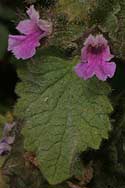 |
Basilicum The
seven species
are found in tropical regions of the Old World with only one species,
Basilicum
polystachyon, found in southern Africa (Mpumalanga, Swaziland and
northern KwaZulu-Natal). |
|
Clerodendrum About 400
species, found in tropical and subtropical regions of the Old World. There
are 13 species native to southern Africa, and 14 species cultivated. A number of species formerly
placed under Clerodendrum are now in the genus Rotheca. Clerodendrum
was formerly
placed in the Verbenaceae. |
|
Clinopodium One
species native to southern Africa - Clinopodium myrianthum (recorded
from Zimbabwe). |
|
Endostemon
The 17 species are native mainly to Africa, with three native to southern Africa. |
|
Englerastrum About 20
species. The only species in southern Africa is
Englerastrum
schweinfurthii which is found along the Okavango and Zambesi Rivers
(Caprivi area) in Namibia. |
|
Haumaniastrum
About 130 species, native to tropical regions of the Old World. There are
five species native to southern Africa. |
|
Holostylon About
four
species, native to tropical Africa, with one species,
Holostylon baumii
found in southern Africa (Botswana). |
|
Hoslundia One species: Hoslundia
opposita, widespread through tropical Africa and extending as far
south as Mpumalanga, Swaziland and northern KwaZulu-Natal. See
Flora of Zimbabwe. |
|
Karomia Nine species, with
one in SE Asia and 8 in Africa and Madagascar. Two species native to
southern Africa: Karomia speciosa, found in Mpumalanga, Swaziland
and KwaZulu-Natal, and Karomia tettensis (see
Flora of Zimbabwe). Previously placed in the
Verbenaceae. |
|
Killickia
Four species native to southern Africa. |
|
Leonotis About 10-15
species, all from Africa, with seven species found in southern Africa. |
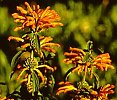
|
Leucas About 150 species,
native mainly to Africa and Asia, with 16 species native to southern Africa. |
|
Mentha (mints)
The 25 species are mainly found in temperate
regions of the Old World. Two species are native to southern Africa
and an additional five species and three hybrids are cultivated in
the region. |
|
Micromeria
One species native to southern Africa. |
|
Neohyptis One species:
Neohyptis
paniculata, distributed from West Africa down through Angola and
Zambia to as far south as northern Botswana in southern Africa. |
|
Ocimum
About 30 species, native to the tropics and subtropics, with 19 species
native to southern Africa and an additional four species cultivated in the
region. |
|
Orthosiphon About 40-50
species, distributed in the tropics of the Old World, with five species
native to southern Africa. |
|
Platostoma
Two species native to southern Africa - Platostoma rotundifolium and
Platostoma strictum (recorded from Zimbabwe, see
Flora of Zimbabwe). |
|
Plectranthus About 300
species, distributed in the tropical and warm regions of the Old World,
with 74 species found in southern Africa. |
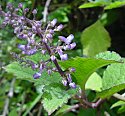 |
Premna About 200 species,
distributed mainly in the warmer regions of the Old World, with two species
in southern Africa. Previously placed in the
Verbenaceae. |
|
Pycnostachys The 37
species are native to tropical Africa and Madagascar, with six species found
in southern Africa. |
|
Rabdosiella One species:
Rabdosiella
calycina, widespread in the eastern parts of southern Africa. |
|
|
Rotheca
Species in this genus were formerly placed in
Clerodendrum. There are 15 species native to
southern Africa. |
|
Salvia (sages) About 900 species, distributed in temperate and tropical regions
worldwide, with 26 native species and four naturalised species in southern
Africa. There are an additional 23 exotic species that are cultivated in
this region. |
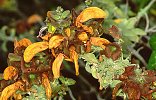
|
Satureja One
species native to southern Africa - Satureja biflora; in addition,
two species from the Mediterranean are cultivated in the region. |
|
Scutellaria About 300
species, distributed widely, with one native species in southern Africa -
Scutellaria schweinfurthii (recorded from Zimbabwe, see
Flora of Zimbabwe).
Scutellaria
racemosa is native to South America and has become naturalised in
southern Africa. |
|
Solenostemon About 60
species, distributed in Africa, Asia and Malesia, with one species native
to southern Africa - Solenostemon rotundifolius. An additional two
species are cultivated in the region. |
|
Stachys About 300,
distributed mainly in subtropical and temperate regions, with 42 species
native to southern Africa. Additionally, one species is naturalised and
three species are cultivated in the region. |
|
Syncolostemon
The 38 species are endemic to southern Africa. |
|
Tetradenia There are six species in the genus, native to tropical Africa and Madagascar, with
six species found in
southern Africa. |
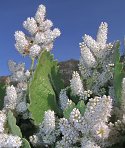 |
Teucrium
About 100 species, found in temperate and warm regions worldwide but most
species occurring in the Northern Hemisphere. Three species are native to
southern Africa and an additional six species are cultivated in the region. |
|
Thorncroftia The five species
are endemic to Limpopo and Mpumalanga. |
|
Tinnea The 19 species are
all African, with six species native to southern Africa. |
|
Vitex
About 250 species,
distributed in tropical and temperate regions, with 18 species found in
southern Africa. Formerly placed in the family Verbenaceae. |
|
Genera naturalised in southern Africa
List from
Plants
of Southern Africa - an Online Checklist (SANBI).
Cedronella One species,
Cedronella canariensis, native to Madeira and the Canary Islands, and a widespread weed on the
Western Cape. |
|
Hyptis
About 300 species, native to warm and tropical regions of America and
Africa. Four species are naturalised in southern Africa. |
|
Lamium About 40 species,
native mainly to the north temperate regions of the Old World. A European
species, Lamium amplexicaule, has become a widespread weed in
disturbed places in southern Africa. An additional two species are
cultivated in the region. |
|
Marrubium About
30 species, native to Europe, north Africa and Asia.
Marrubium vulgare is
a weed in southern Africa. Additionally, Marrubium incanum
(native from Italy to Albania) is cultivated in the region. |
|
Prunella About 5-7
species, found in the temperate regions of both hemispheres, but in
southern Africa there is only the introduced
Prunella vulgaris which
has become naturalised in wet vleis and along forest margins in
KwaZulu-Natal. Prunella grandiflora (Large selfheal), native
to Europe, is cultivated in southern Africa. |
|
Other genera, cultivated in southern Africa
List from Glen (2002). The species name is provided in
genera that have only one species cultivated in southern Africa.
|
Acinos arvensis (Basil thyme)
Indigenous from Europe to western Asia. |
|
|
Agastache
Two species cultivated - Agastache cana (native to Texas) and
Agastache foeniculum (Anise or Giant hyssop) (native to western USA). |
|
|
Anisomeles malabarica
Indigenous from Mauritius to Malaysia. |
|
|
Calamintha glandulosa (Lesser calamint)
Native to southern and western Europe. |
|
Callicarpa
Five species cultivated. Previously placed in the
Verbenaceae. |
|
Caryopteris
Two species cultivated - Caryopteris incana (native to China and
Japan) and Caryopteris odorata (native to India). |
|
|
Clinopodium vulgare (Wild basil)
Native to Europe. |
|
|
Coleus thyrsoideus
Native to tropical Africa. |
|
|
Colquhounia coccinea
Indigenous from India to China. |
|
Congea tomentosa
Indigenous from India to Vietnam. Previously placed in the
Verbenaceae. |
|
|
Dracocephalum moldavica
Indigenous from Eurasia to China. |
|
|
Galeobdolon luteum (Yellow archangel) |
|
|
Glechoma hederacea (Ground ivy, Alehoof)
Indigenous from Europe to the Caucasus. |
|
Gmelina
Four species cultivated. Previously placed in the
Verbenaceae. |
|
|
Hedeoma pulegioides (American pennyroyal)
Native to eastern USA and Canada. |
|
Holmskioldia sanguinea (Chinese hat plant)
Native to India. Previously placed in the
Verbenaceae. |
|
|
Hyssopus officinalis (Hyssop)
Native to southern Europe. |
|
|
Lavandula
(lavenders)
Eight species and two hybrids cultivated. |
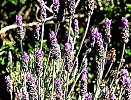
|
|
Leonurus
Two species cultivated - Leonurus cardiacus (Motherwort) (native to
Europe) and Leonurus sibiricus (native from eastern Siberia to China). |
|
|
Lepechinia chamaedryoides
Native to Chile. |
|
|
Melissa officianalis (Lemon balm)
Indigenous from Europe to Iran. |
|
|
Moluccella laevis (Bells of Ireland, Shell flower)
Indigenous from Cyprus to Iraq. |
|
|
Monarda
Four species cultivated. |
|
|
Monardella undulata
Native to California. |
|
|
Nepeta
Six species and one hybrid cultivated. |
|
|
Origanum
Four species and one hybrid cultivated. |
|
Oxera pulchella
Native to New Calidonia. Previously placed in the
Verbenaceae. |
|
|
Perilla frutescens (Yegoma)
Native to Southeast Asia. |
|
|
Perovskia atriplicifolia
Native to Afghanistan and Pakistan. |
|
|
Phlomis
Two species cultivated - Phlomis fruticosa (Jerusalem sage) (native to
the Mediterranean) and Phlomis russellia. |
|
|
Physostegia virginiana (Obedient plant)
Native to the USA. |
|
|
Pogostemon
One unidentified species cultivated. |
|
|
Prostanthera Three species cultivated (all from eastern
Australia). |
|
|
Rosmarinus officinalis (Rosemary)
Native to the Mediterranean region. |
|
|
Sideritis candicans
Native to Madeira. |
|
Tectona grandis (Teak, Indian teak)
Indigenous from India to Laos. Previously placed in the
Verbenaceae. |
|
|
Thymus (thymes)
Seven species and one hybrid cultivated. |
|
|
Westringia fruticosa
Native to eastern Australia. |
|
Publications
-
Retief, E. 2000. Lamiaceae. In: Seed Plants of
Southern Africa (ed. O.A. Leistner). Strelitzia 10: 323-334.
National Botanical Institute, Pretoria.
-
Glen, H.F. 2002. Cultivated Plants of
Southern Africa. Jacana, Johannesburg.
|
